- About The Journalist’s Resource
- Follow us on Facebook
- Follow us on Twitter
- Criminal Justice
- Environment
- Politics & Government
- Race & Gender
Expert Commentary

White papers, working papers, preprints, journal articles: What’s the difference?
In this updated piece, we explain the most common types of research papers journalists will encounter, noting their strengths and weaknesses.

Republish this article

This work is licensed under a Creative Commons Attribution-NoDerivatives 4.0 International License .
by Denise-Marie Ordway, The Journalist's Resource February 25, 2022
This tip sheet, originally published in May 2018, has been updated to include preprint research, a type of research featured often in news coverage of the coronavirus pandemic.
Journalists rely most often on four types of research in their work. White papers, working papers, preprints and peer-reviewed journal articles.
How are they different? And which is best?
Below, we explain each, pointing out its strengths and weaknesses. As always, we urge journalists to use care in selecting any research to ground their coverage and fact-check claims.
Peer-reviewed article
Peer-reviewed research — the kind that appears in academic journals and that we highlight here at The Journalist’s Resource — has undergone a detailed critique by scholars with expertise in the field. While peer-reviewed research is generally the most reliable, journalists should keep in mind that publication in a prestigious journal is no guarantee of quality and that no single university or research organization always does the best research on a given topic.
It is safe to assume, however, that articles published in top-tier journals have been reviewed and given a stamp of approval by a number of accomplished scholars. For journalists who are uncertain, we’ve put together a list of 13 questions to ask to gauge the quality of a research article.
Keep in mind that not everything that appears in a scholarly journal has been peer reviewed. Journals publish various types of content, including book reviews, editorials, letters to the editor and, sometimes, even poetry.
Working paper
This broad category describes research papers that have not been peer reviewed or published in a journal. Working papers can be in various stages of completion. One might be ready for publication in a prestigious journal while another requires significant editing and other changes that could actually alter its main findings. Sometimes, working paper findings are so preliminary, authors will advise against citing their work .
Even so, working papers are a great way for journalists to gain access to new research quickly. The peer-review and publication process can take months to a year or longer, which means that by the time studies get published, their findings are sometimes not as useful or the data are old.
In choosing working papers, journalists should communicate with scholars about the progress of their research and how confident they are in their findings. It’s a good idea to seek corroboration from peer-reviewed research and to ask other researchers for help assessing a study.
A preprint is similar to a working paper in that it has not been vetted through a formal peer-review process. However, preprints tend to be more complete . Also, preprints submitted to public servers such as the Social Science Research Network and the health sciences server medRxiv get a cursory screening before they’re published online for public view.
Preprints, like academic journal articles, are assigned a Digital Object Identifier , or DOI, and become a permanent part of the scientific record.
White paper
A white paper is a report, often compiled by government agencies, businesses and nonprofit organizations, that outlines an issue and often explores possible solutions to a problem. For example, in November 2021, the federal Office of Community Oriented Policing Services released a white paper looking at factors that help or hinder law enforcement recruitment of Black Americans. Earlier in the year, the Advanced Technology Academic Research Center published a white paper on the American Rescue Plan ‘s widespread implications for government agencies.
In the business world, white papers also are used for marketing purposes — to describe a new product or approach, for instance, or diagnose a problem.
While a white paper can help journalists get up to speed quickly on an issue, it’s important to note some white papers advocate a specific position or policy change. Some rely on incomplete research or research that has not been peer reviewed.
Looking for more guidance on writing about research? Check out our tip sheets on covering biomedical research preprints amid the coronavirus and what journalists should know about peer review .
The Journalist’s Resource would like to thank Matthew Baum , the Marvin Kalb professor of global communications and professor of public policy at Harvard Kennedy School, for his help preparing this tip sheet.
About The Author
Denise-Marie Ordway
Research paper vs white paper: how are they different?
- September 14, 2022
Research paper vs white paper is a conundrum white paper writers frequently encounter. Most people had to write research papers when they were in high school and college, and many people work in industries where researchers and scientists publish research papers to inform colleagues and industries of what they’ve learned. So when they hear someone mentioning white papers, they can’t be faulted for assuming they’re the same thing. (Originally, a white paper was an official government report.)
What are research papers?
Research papers are formal documents or scientific articles exploring a particular subject in detail, and supporting the writer’s contention or arguments by including evidence from outside experts and other sources. Most research papers follow standardized structures, often beginning with some type of a thesis statement, presenting a series of arguments or sources in support of that statement, and ending in a statement about whether the thesis was successfully proven.
For students, academic papers are usually assigned to determine their mastery of a topic or their ability to write in traditional academic style. Professionals use peer reviewed research papers for a different reason. They want to share an idea they had and whether it proved to be possible, useful, or even valuable.
Scientific papers
Peer reviewed research papers are particularly important in the sciences. For example, many medical advances are first documented by the doctors or other scientists who discovered and tested them. An oncologist may stumble upon a combination of treatments that’s particular effective on a difficult-to-treat cancer. The doctor tests his idea following standard procedures and protocols and discovers it’s effective 86 percent of the time, so they write a research paper explaining the treatment and recommending the next steps for researchers.
The scientific research paper process is designed to explore all existing knowledge to create new ideas and discoveries, then document everything to help the scientist who pushes the frontiers of knowledge even further.
Publishing research papers
Recognition of the value of what a particular research paper analyzes often comes in the form of being published in an peer reviewed academic journal. Generally, an academic journal uses a peer review process in which several professionals read papers that have been submitted before publishing research papers. They ensure a logical framework is used and also make sure any statistics and other information used reflect peer reviewed research standards.
What is a white paper?
White papers are documents that explore complex issues to educate audiences. When used in a marketing or policymaking context, a white paper provides enough facts and arguments to convince people that your product, service, or strategy offers the best solution for the situation, educating them about the issue and making a case for your position or advice. Potential customers search for the information found in white papers.
White papers offer an excellent way to explain what makes your solution better than competing alternatives. You can use them to provide a technical discussion or summarize key information about a particular issue or problem to help the reader develop a stronger understanding. You describe common problems current and prospective customers face and provide detailed explanations as to how your approach provides the best solution.
Unlike ads and brochures, white papers are generally not promotional, without a strong sales pitch. Because the audiences that white papers target — such as engineers, CFOs, and CEOs — tend to distrust materials that appear to be more “salesy” than informative, most white papers are simply set up to look like trade magazine articles with fewer pictures.
So research paper vs white paper?
As in how they are different? First, they have two very different purposes. The purpose of a research paper is, for students, to prove mastery of a subject. For professionals, it’s to advance knowledge by sharing discoveries. A white paper, on the other sheet, is a tool to share information and influence decision-making.
Research papers explore all existing knowledge and can never have enough of it. White papers focus on a handful of points. Just enough knowledge to help someone make the right decision and nothing more. Research papers expand the mind, white papers attempt to narrow it.
Typically, research papers are written in the stiff, formal style that’s used in the academic world. You’ll have no trouble recognizing it from your memories of 8th grade English or your college composition class (or whatever fancy term your college came up with because they didn’t think you were smart enough to realize it was a composition class). Remember that long list of rules Mrs. Handsdown recited and all the red ink on your graded papers? Now when you write an email, you sometimes worry that she’s somehow going to see it, and you’ll feel her hovering over your shoulder.
The most effective white papers are written in a friendly, conversational way . Mrs. Handsdown would be very disappointed in you, but your boss will think you’ve become a genius. How so? It starts with the voice and tone of the written word. So you’re already a little confused. How could the written word make sound? Well, I didn’t say that. I said the voice and tone and not sound.
Literacy — the ability to read — is a relatively recent development in the evolution of our species. From the time we were magically created, hatched, or (whatever your image of life celebrates), until mere centuries ago, we had no way to communicate in writing. So we spoke. More important, we listened. Listening could keep us alive. Gradually, we learned the value of sharing what the old had learned from life so the young could take their places.
That was a long time ago, but you know what’s funny? Much of our mental wiring is from that era. Our brains do a great job of collecting and managing information. Was that the doorbell? Did a bird hit the window? Is that noise coming from beast of sharpest teeth? Your brain reacts to all three events the same way. It triggers hormones to kick up your energy and sharpen your senses so you don’t miss a thing. Thanks to some mutual ancestor who managed to stay a step ahead of a sabertoothed tiger, sound gets our immediate interest.
So we’re conditioned to listen for and pay attention to voices. Think of how many of the best times you can remember were spent in conversation with friends or family. Think of the number of interactions you have with other people on a given day, and what percentage include at least some conversation, even if it’s just “mornin’.”
As children, we grasp reading by connecting words with their associated sounds. And because the spoken word is so comfortable for us, we begin to recognize it in what we read. As we read a paragraph, we “hear” a voice in our heads. The voice is how we think the author or the character sounds. Not sure what I’m saying? Have you ever read a book and then seen a movie made from the book? A character speaks and you think, “Hey! He doesn’t sound like that!” You heard his “voice” when you read the book.
Based on the voices they hear, people draw very important conclusions about you. They decide whether you can be trusted. How you will treat them. Whether you’re genuinely friendly or just acting nice. You can control that impression, because you can control that voice.
Sometimes, presenting the right voice means ignoring some of those grammar rules Mrs. Handsdown drummed into your head. Why? Effective copy talks to people, and people don’t speak with textbook grammar. We start sentences with conjunctions, we end them with prepositions. We even use fragments. (That doesn’t mean grammar is unimportant. Forgetting basic agreement or structure can make you sound uneducated. Don’t be afraid to break rules – but do it selectively and with reason.)
By writing a white paper in a friendly, conversational way, you’ll tap into our desire to listen to voices and do a better job of capturing the reader’s full attention.
Is grammar for research and white papers different?
As I mentioned, research papers are usually written in that formal, stuffy academic style taught in high school English and college Composition classes and often used by technical writers.
But writing white papers isn’t about trying to please strict English teachers or jaded Composition instructors. Writing white papers is about selling. Telling. Convincing. Entertaining. Emphasizing. Doing that effectively demands copy that’s individual and personal. In fact, the more copy sounds like conversation, the more effective it tends to be.
That doesn’t mean you should ignore basic rules of grammar and syntax. The degree of grammatical correctness should reflect the situation and the audience. If the primary audience for your white paper is a group of university professors, you’ll want to make it more formal. But if you’re writing to industrial purchasing agents, your white paper should use the kind of language they use every day.
How should white papers be written?
Again, the most effective kind of language to use in a white paper is conversational. It really is okay to use contractions (like “can’t” or “won’t”) because they keep copy talky and friendly. It’s also okay to start sentences with conjunctions like “and” or “but,” and to end them with prepositions. And while you learned not to use “you” when writing for school, using it in a white paper will make it seem more like a conversation you’re having with the reader.
Some companies believe in hiring technical writers for white papers, but technical writers are usually more geared to projects like documentation or manuals, not white papers.
As for format, white papers usually begin with a general summary of the issue or the problem, and then go into depth about that issue or problem. Once it has been explored at length, the paper explains the solutions or approaches that have been developed to address the issue or problem, with a focus on the solution or approach that you want to advance. White papers often end with a brief message about your company and what it offers to prospective customers.
Some white papers include a short abstract at the beginning of the paper to summarize the key messages and conclusion. You can also place a list of other references and sources that the reader may find informative at the end of the paper.
Are there different types of white papers?
Companies may use several types of white papers companies as part of their marketing communications efforts. Most white papers fall into one of the following four categories.
1. White papers for background information
Some white papers are designed to provide background information about an issue or a challenge. Their goal is educating the reader about the matter so they can make more informed and/or confident decisions. An example might be comparing the advantages of shipping by truck with those of shipping by train, so a decision-maker is better able to evaluate which is the right choice for their company.
2. White papers for problems and solutions
Many white papers begin by describing a common problem the audience faces — whether that’s machinery that’s breaking down too often because of contamination issues or erosion tearing the topsoil from newly built slopes. Then the white papers examine the solutions available for that problem. With the machinery, it might involve a different type of lubrication or changes to the maintenance schedule. With the erosion issue, it might involve woven mats of organic materials that help plantings become rooted more quickly so they’re better able to withstand water.
3. White papers about processes
White papers can be an excellent way to explain and explore processes, from the many steps in bringing fresh produce from a farmer’s field to a restauranteur’s table, to the insight professionals like architects bring to design and construction of buildings. A well-written white paper can bring these processes alive for people who need to know about how these things work, such as lawmakers who are considering legislation about affecting those processes.
4. White papers presenting collections of information
This strategy is best when you have many bits of information or advice that would be helpful to readers, but none of them warrants a full-length white paper of their own. They’re often presented as numbered documents with titles such as “20 simple ways to improve your fleet maintenance program.” Readers are often attracted to this type of white paper because it’s easy to read and normally simplifies otherwise complex topics.
Could our business benefit from white papers?
If you can answer “yes” to any of the following five questions, it’s likely white papers can help you. In fact, more “yes” answers you provide, the more likely white papers should be part of your organization’s toolkit.
1. Is what you offer complicated, innovative, or different than your competitors?
If your company’s product or service is complicated, innovative, or significantly different from what your competitors provide, creating a white paper may be one of the most effective ways to convince people it’s the best choice for them.
That’s because selling something complex or innovative demands helping the prospect see why it represents a better choice. It’s hard to do that convincingly in an ad or email, but a well-written white paper provides enough facts and arguments to educate them while helping them reach the decision you want.
2. Is advertising not sufficient to explain the advantages of what you offer?
While advertising or other traditional marketing methods can be effective channels, they rarely allow you to get into detail about what makes your product or service better. Plus, many people are wary of channels such as advertising because they know it’s a blatant sales effort.
A well-crafted white paper is an informational tool that seeks to educate the reader. Because the white paper doesn’t appear to be as promotional, people will give it more credence. Plus, people tend to hang onto white papers longer than they retain ads, giving your message a longer life.
3. Do prospects and customers find it hard to grasp your value proposition?
Like you, your customers and prospects are hungry for good information, but they’re also busy. Because their time is limited, they appreciate practical guidance that’s focused on their specific needs, and they trust white papers more than other channels.
They’re willing to take the time to read white papers because they need to know something. Maybe they want to better understand a new technology. Perhaps they’re desperately seeking a solution for a problem that’s hurting their business. Or it could be that they want support for a recommendation they’re making to their bosses. Whatever the reason, white papers provide trustworthy information and improve their perception of your organization and what you offer.
4. Is your sales process lengthy?
If your product or service is a commodity, is easily understood, or typically is purchased on impulse, a white paper probably won’t do much for you. But if you’re selling a high-value product or service that takes many weeks or months to move from initial interest to finished deal, a white paper can help you speed the process along.
5. Does your customers’ decision-making process involve many people?
Often — particularly with items that involve a significant investment of capital, such as plant equipment — purchase decisions are not made by just one or two people at your prospect. They may have the status and authority to recommend what you offer, but getting final approval may require the blessing of everyone from production engineers, to the operations team, to the CFO and CEO. Unfortunately, you and your team can’t speak with everyone who will play a role in the decision.
That’s when a white paper can stand in for you. A white paper that discusses the advantages of what you offer, contrasts it with other options, and explains how users can get the greatest value from it will help you communicate with decision-makers you can’t reach directly. When your contact attaches your white paper to their recommendation, it not only provides evidence that it’s the right choice, but it may help to answer questions and overcome objections other people in the process may have.
You may also like

Features and Benefits: How to Use Both In White Papers

How Non-Profits Can Leverage White Papers

Leveraging Educational White Papers as a Powerful Marketing Strategy
Our daily newsletter.
Get the latest and our most important news
I agree to the privacy policy .
- +61 2 8091 4990
- +1 (315) 636-4830
- +44 2071 939560

- What we offer
- Blog Writing
- Pillar Articles
- White Papers
- Case Studies
- Website Copywriting
- Industries we help
- Portfolio & FAQs
Follow us on
Engineering Copywriter Blog
Content marketing tips and insights to help grow your engineering audience, what is the difference between white papers and research papers.

Estimated reading time: 4 minutes
If you’ve ever read research papers and white papers and thought they were kind of the same thing, well, this article is here to say otherwise. As similar as they may look in structure, these two papers have their own distinctions. It is important as a consumer to understand how these two differ from each other. Therefore, in this article, we will present the key differences between a white paper and a research paper.

Image Source: Pixnio
We define research papers as academic papers published in journals that contain results of original research or an evaluation of research conducted by others with the overarching aim of contributing to a body of knowledge. These are often reviewed by scholars with experts in different fields of science and technology. Research papers are usually written in order to prove or disprove a theory, demonstrate research results, and show new discoveries. Research papers show the strength and weaknesses of their proposition in a transparent manner as it provides evidence in a logical framework. Publishing research papers usually takes a long time as it requires peer reviews.
White papers show outlines on a particularly complex issue and tackle the best solution to that particular problem. They are more focused on solving industry problems presented through a technical discussion. White papers are typically used to advocate for a certain position or product and are often utilized in marketing to influence a customer’s purchasing decision. It is meant to impact customers in one conclusive direction that favors the company but it is presented in a factual and logical manner.
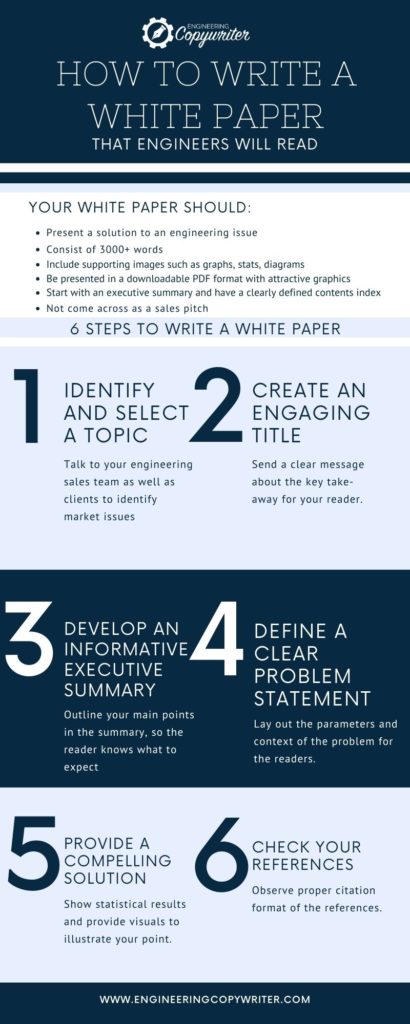
The people behind research papers are academic scholars who are knowledgeable in that certain fields of the discussed topics. They are mostly engineers, scientists, doctors, surgeons, and postgraduate students among others. Their written works are backed by various sources written by other experts on the same topic. For research papers, knowing the author who publishes the research is important for credibility and their professional experience is also of key importance. Future references for research papers must include the author.
In contrast, in-house company staff, subject matter experts, or writers under contract for example are the ones who are responsible for writing white papers. It is important to understand that white papers focus more on the company or its product rather than the author. White paper authors may or may not have background information regarding a topic, and they often produce content through research. They are solely hired by companies for the purpose of creating the document. Hiring technical writers is becoming an industry norm and would be both beneficial and profitable to sponsoring companies.
Since research papers are mainly written for information and education, their main readers are those who are in the academic field like students, professors, researchers, and scientists. It is presented through scientific publications, lectures, conferences, and interviews.
White papers are targeted at potential customers to attract more interested buyers on a certain product, service, or brand and therefore, potentially increase the company’s profits. It is mainly used to impact the reader’s decision into adhering to the product or approach that the paper is supporting.

In essence, a research paper analyzes a perspective or argues a point backed up with the ideas and information of other credible people. It presents the results of a study or lengthy experiment without any bias in order to contribute to the overall scientific body of knowledge.
White papers, on the other hand, are used to advocate a specific good or trade name. It directs the reader to make a specific decision using facts and logic. They are widely used for commercial purposes and could influence the judgments of current and prospective customers.
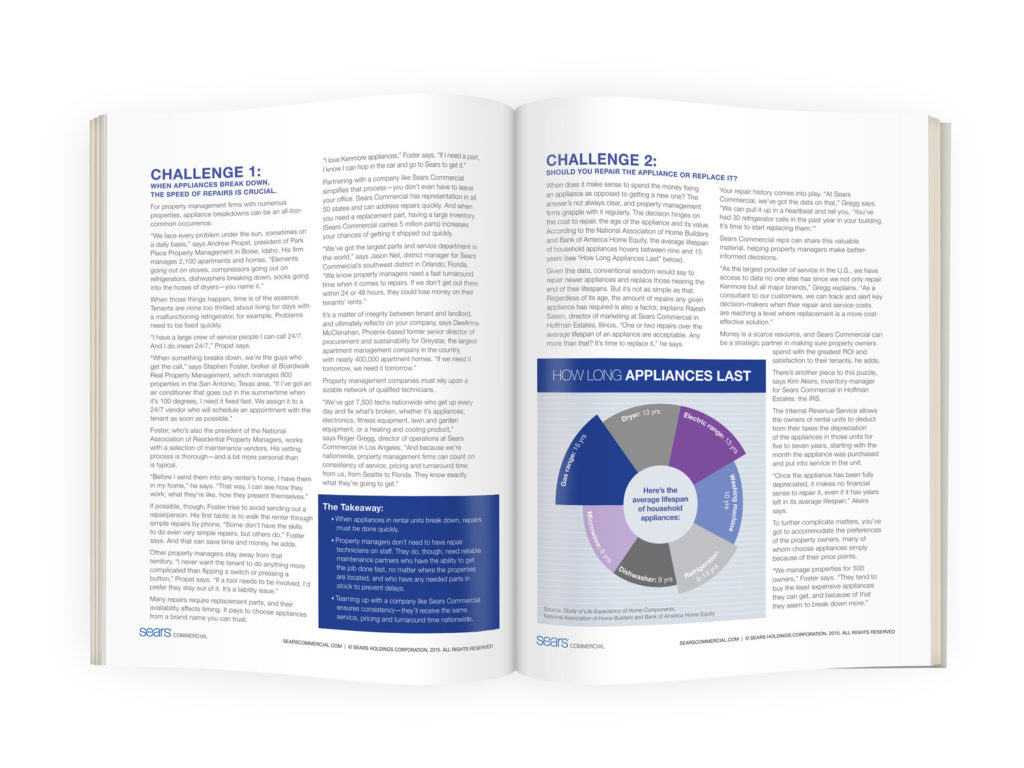
Image Source: Copy Press
A research paper is written to present facts and results backed by credible data from other experts in the field and is meant to add to the overall knowledge on that specific topic, to encourage future research, or just clarify a certain fact.
A white paper, on the other hand, is written with the intent to persuade the reader to reach a specific conclusion and if that reader does reach that desired conclusion, it is considered a sale or profit. A white paper may not outrightly contain a sales pitch but the content is carefully crafted so as to influence the reader in a certain way that profits the company that publishes it.
If you need help with the copy for your engineering white papers – get in touch with our professional team of writers today.
Share this:
Related posts.

Is an SEO Strategy Really That Important?
I won’t leave you hanging: Yes, it is. And if you’ve been trying...

SEO Basics and Keyword Research Tips for 2024
If you’re working on driving traffic to your engineering website, you’re hopefully already...
for getting in touch. We really appreciate it!
Someone from our team will get back to you within 48 hours.
In the meantime, click here to check out our free blog posts and get some ideas on how to better market your engineering business.
Privacy Policy
Purdue Online Writing Lab Purdue OWL® College of Liberal Arts
White Paper: Purpose and Audience

Welcome to the Purdue OWL
This page is brought to you by the OWL at Purdue University. When printing this page, you must include the entire legal notice.
Copyright ©1995-2018 by The Writing Lab & The OWL at Purdue and Purdue University. All rights reserved. This material may not be published, reproduced, broadcast, rewritten, or redistributed without permission. Use of this site constitutes acceptance of our terms and conditions of fair use.

What is a White Paper?
Originally, the term white paper was used as shorthand to refer to an official government report, indicating that the document is authoritative and informative in nature. Writers typically use this genre when they argue a specific position or propose a solution to a problem, addressing the audience outside of their organization. Today, white papers have become popular marketing tools for corporations especially on the Internet since many potential customers search for information on the Web. Corporations use white papers to sell information or new products as solutions that would serve their customers' needs.
The Purpose of a White Paper
Typically, the purpose of a white paper is to advocate that a certain position is the best way to go or that a certain solution is best for a particular problem. When it is used for commercial purposes, it could influence the decision-making processes of current and prospective customers.
What Kind of Problems Do Readers Want to Solve?
The audience for a white paper can be the general public or multiple companies that seek solutions to their problems or needs. Typically, you will not know your audience personally, unlike when you write a recommendation report for your client. And yet, in order to persuade your audience, you need to focus on their needs. If you can address the problems that your readers want to solve, they will read your white paper for a solution. Otherwise, your white paper may not be read. It is important to emphasize your readers' interests rather than your interests, as shown in the example below:

3 Key Differences Between White Papers and Scientific Papers

On the surface, commercial white papers and scientific papers published in journals appear similar. They are both presented with an emphasis on narrative rather than design, so neither will have flashy artwork or photographs and statistics are presented in black and white tables or graphs. They are similar in length - from 6 to 12 pages, give or take. Both will have citations, either as footnotes or end notes, using current research from respected journals and thought leaders. Even the formatting will look similar, with section headings including a brief summary, background, analysis, and presentation of data. Looking behind the surface, however, reveal 3 important differences.
Difference #1: The Author
Commercial white papers are written by a company's in-house staff or by a freelance writer under contract. The writer meets with the marketing staff to discuss the information to be presented, to determine an angle, and set parameters on facts and messaging. The author may have a background in the topic or product, but this is not required. The entire process can take anywhere from 25 - 50 hours to complete, from planning to publication. Final editing and approval is granted by the sponsoring company. Ultimately, the white paper reflects directly on the company that sponsors it, not directly to the author.
This anonymity could not be further from the authorship of scientific journal articles. For these documents, the authors are not only responsible for the narrative, they are also the lead investigators in the study, the experts analyzing data for their peers in the scientific world. Their published work is inexorably tied to their names, their careers, and their professional legacy. Important publications will continue to be cited in future work, each citation listing their name and article. Journal authors also take complete responsibility for the content of their articles, presenting their data at conferences, answering questions for interviews, and providing additional materials to those researchers wanting to know more. Final approval for these publications is granted by a panel of peer editors as well as the journal editor, often after several rounds of edits and clarifications that can take up to a year - in addition to the months or years required for the study itself.
Difference #2: The Goal
The goal of the white paper is to direct the reader towards making a specific decision . In one definition of a white paper, this type of document is "a persuasive essay that uses facts and logic to promote a certain product, service, or viewpoint." The author directs the reader to a specific conclusion using carefully-selected facts and logic, all with the desired result of portraying the product, service, or viewpoint in the best possible light.
In contrast, an academic paper will present the results of a study in order to contribute to the body of scientific knowledge , "warts and all." That is to say, the author's goal is to put forward data with analysis that add to the scientific conversation, to help clarify a bigger picture, and hopefully encourage further research. The author will build a logical framework with evidence from previous work, while acknowledging opposing viewpoints or possible contradictions. Every scientific paper will contain clear mention of the study's strengths and weaknesses, and any concluding statements will be carefully phrased in order to remain open-ended and neutral.
Difference #3: The Results
If the goal of the white paper produced by a for-profit company is persuading the reader to reach a specific conclusion, then the desired result of that document is a sale by the company that sponsored it . A white paper may not contain a sales pitch, but its carefully crafted message is intended to guide the reader to a specific decision: Investment in the product being described.
For a scientific journal article, the goal is to add to the body of knowledge in a meaningful way. Evidence of the relevance of this contribution can be the citation of that work in future presentation and/or articles published in the same field. Authors of significant work may also benefit from career advancement, requests for presentations at conferences and symposia, and availability of granting opportunities to continue their research. These results may seem amorphous to the layperson, but contributing to the vast body of academic knowledge is the pursuit of every research scientist. Just as the teacher aims to awaken a love of learning in a student, or a doctor works to heal a patient, the research scientist hopes to add a brick to the growing foundation of scientific knowledge, knowing that the brick may be the keystone to even greater discoveries.
This is not to say that all scientific papers add meaningfully to the body of knowledge, nor that all white papers are devoid of scientific value. Not all scientific papers are devoid of corporate influence, with some companies investing in research that then is published in an academic journal (with full disclosures in the publication). And not all white papers are a part of a corporate sales funnel. There are white papers produced by non-profit organizations, including professional associations, that are also persuasive rather than neutral. (An example would be a white paper about climate change produced by an environmental non-profit agency.) In these cases, the goal is to present and defend a specific viewpoint with no direct sales or commercial interest in mind. Some of these types of white papers will be published by trade magazines, appear in conference proceedings, and even be cited in other literature. While they are not neutral per se, they are not commercial in intent.
Commercial white papers can be helpful. For a potential customer considering a product, it can present a lot of information and statistics in a streamlined form, help the reader convince others about their support of a product, and identify practical ways to decide whether or not the product is a good match for one's needs. It's important for readers to always keep in the back of their minds, however, that it is a marketing tool that may not present a complete picture. In an academic hierarchy , the scientific paper will be considered superior, since they are unbiased and peer-reviewed. Ideally, a consumer will use both white papers and scientific research to make the best decision for their needs.

Editor's Note: This post was originally published in December 2016 and has been updated for freshness, accuracy and comprehensiveness.
Blog comments
Related posts.

Scientific Journals: From the Lab to the World

Science and Politics, Part 3: Funding Science

Internal and External Validity
Lydon and O'Leary libraries will be closing at 2:00pm on Wednesday, July 3rd , and will be closed on Thursday, July 4th . If you have any questions, please contact [email protected] .

- University of Massachusetts Lowell
- University Libraries
White Paper Style Guide
- When to Use a Whitepaper
- How to Format a Whitepaper
- Citation in Technical Papers
Links to Helpful Content
- Purdue OWL Video on Writing White Papers
- WhitePaper Guy, (Gordon Graham)
White Paper or Whitepaper?
White paper is more widely used and it has strong documentation to back it up. At the end of the day, white paper is the safer choice. You won't be wrong for choosing to use the space-separated version. When it comes down to it, whitepaper is an acceptable preference at best, while white paper is the standard. (from blog linked above, May 12, 2016)
(In 2022, the age of the adjective/noun mashup for naming apps and businesses, this seems a quaint opinion.)
A white paper is a research-based report which offers a focused description of a complex topic and presents the point of view of the author or body represented by the author. The purpose of a white paper is to give readers understanding of an issue, which in turn helps them solve a problem or make a decision.
The term originated in Britain, where it refers to a type of government issued document. In a business context, the purpose of white papers has evolved to an aspect of marketing and is often used to persuade.
Key Characteristics of White Papers
White paper experts including Gordon Graham have identified these key characteristics for a white paper:
- A document containing narrative text
- At least 5-6 pages long
- Oriented in portrait format (landscape format tends to be for B2B e-books)
- Educational, practical and useful, not a sales pitch
- Used before a sale, not after a sale
- Provides facts, not just opinion
- Includes an introduction or executive summary
If a document has all these characteristics, it’s probably a white paper
from "That White Paper Guy"
Purpose of White Papers
"A whitepaper is a persuasive, authoritative, in-depth report on a specific topic that presents a problem and provides a solution.
Marketers create whitepapers to educate their audience about a particular issue or explain and promote a particular methodology. They're advanced problem-solving guides. Typically, whitepapers require at least an email address for download (usually they require information more than that), making them great for capturing leads."
A whitepaper is NOT:
"A product pitch. Although Investopedia , [see above], defines a whitepaper as 'an informational document issued by a company to promote or highlight the features of a solution, product, or service', be warned that overtly shilling your own stuff could turn off your readers. The goal of a whitepaper is to inform and persuade based on facts and evidence, not tell the world why your product is the best and they need to buy it now." [Investopedia seems to have backed off from this stance.]
from Hubspot
- Next: How to Format a Whitepaper >>
- Last Updated: May 11, 2023 1:13 PM
- URL: https://libguides.uml.edu/whitepaper_style
What is a white paper and how to write it with examples
Dec 9th, 2022

What is a white paper?
How to write a white paper, white paper examples, should you gate your white paper.
- Share this article
If your business objectives are to promote your product or service, generate leads, establish thought leadership and encourage your potential customers to purchase the product, you can create a white paper. Marketing specialists write white papers to educate their audience about a specific topic or describe and promote some methodology. These in-depth reports can highlight the features of your product or service and help your customers find solutions to their problems.
However, to create an excellent white paper, you must have clear goals, relevant topics, and new information to share. In this article, we will take a closer look at white papers, consider their unique features and describe the differences between white papers, case studies, ebooks, and blog articles. We will also discuss the process of writing a white paper and provide several examples of this content type.
A white paper is a report or guide that gives a thorough overview of a topic while promoting a company’s goods or services and enticing readers to use them. A white paper presents a potential solution to customer problems, describes the product’s features and justifies why a product or service is the perfect option for the given issue. In addition, this marketing document contains studies, surveys, and other statistics supporting the provided information. The audiences for white papers include prospective clients, investors, journalists, analysts, and stakeholders.
A white paper is a form of content marketing or inbound marketing. It is a piece of content that allows for generating traffic and increasing the company’s visibility in search engines. A document is typically written in an academic style and contains at least 2,500 words. White papers are created for two primary purposes: educating potential customers about the topic while positioning a company as an authority and encouraging consumers to purchase the offered product or service. In addition, whitepapers are often presented as gated content , so consumers should fill out a form with their contact information to download material.

There are three categories of white papers: backgrounder, numbered list, and problem/solution. The backgrounder describes the technical or business advantages of the product. This white paper is most effective for supporting a technical evaluation or product launch . A numbered list or listicle provides a series of recommendations, questions, or points regarding a specific business issue. These white papers are intended to draw attention with provocative ideas, nurture leads , or cast doubt on competitors. Finally, problem/solution papers present a new solution to a problem, generate leads, and inform and persuade stakeholders.
Although a white paper is a sales document, it differs from a product pitch or presentation. A white paper is useful and informative and provides only facts without opinions. It aims to build trust with the audience and increase brand awareness . Sales pitch, in contrast, is written in a more aggressive tone and focuses mainly on the product’s benefits. While the goal of a product pitch is to convince the audience to buy your product straight away, a white paper uses facts and logical arguments to inform the readers about your solution and explain why it is the best choice.
Now we will compare a white paper with a research paper, case study, ebook, and blog article and look at their distinctive features.
White paper vs research paper
Research papers are scholarly publications in journals that feature the findings of original studies or criticism of other researchers’ works. A research paper aims to contribute to the body of knowledge in a particular field. Research papers are usually written to support or refute a theory and present recent findings. These publications are frequently examined by academics who are specialists in various branches of science and technology. It often takes a long time to publish a research paper as it requires peer reviews.
White papers typically address complex issues through technical discussions. These documents are used in product marketing to highlight a specific viewpoint or product and influence consumer purchasing decisions. Although a white paper is presented scientifically and logically, it is intended to impact customers in a way that benefits the business. While research papers are created by engineers, scholars, and doctors, the authors of white papers are technical writers, internal company personnel, and subject matter experts.
Research papers are mostly published for informational and educational purposes. Hence academics like students, professors, researchers, and scientists make up the majority of their readers. On the other hand, white papers’ audience is prospective customers, so they might increase sales of a specific brand, product, or service.
White paper vs case study
A case study is a record of research conducted to examine a specific problem or circumstance during a given period. For example, in a business case study, an author may explore the organization’s strategy, analyze how consumers use a product, or describe the state of the market. The goal of a case study is to educate readers, inform the audience about a problem and provide recommendations. In essence, both a white paper and a case study describe the advantages of a product or service while demonstrating how a particular method has turned out to be an efficient remedy for the problem.
However, there are some significant differences between white papers and case studies. Case studies are more concise, while white papers are longer, involve technical research, and provide detailed suggestions on resolving the issue. The former demonstrates the effectiveness of a solution and provides real-life examples. Case studies also place greater emphasis on observation and examination. White papers, in contrast, focus primarily on theoretical information and highlight crucial characteristics of a product or methodology.
White paper vs ebook
An ebook or electronic book is a digital publication that contains text, photos, and interactive elements like links and videos. Ebook provides recommendations, answers, or strategies for an industry or niche. White papers and ebooks share certain similarities. For instance, both marketing assets can be used to establish a company as a thought leader, build credibility and generate leads. Besides, ebooks and white papers have a longer lifespan than other content marketing formats. You can use the documents for a few years and repurpose them in different ways: turn them into a series of blog articles, create an infographic, or include the publications in newsletters.
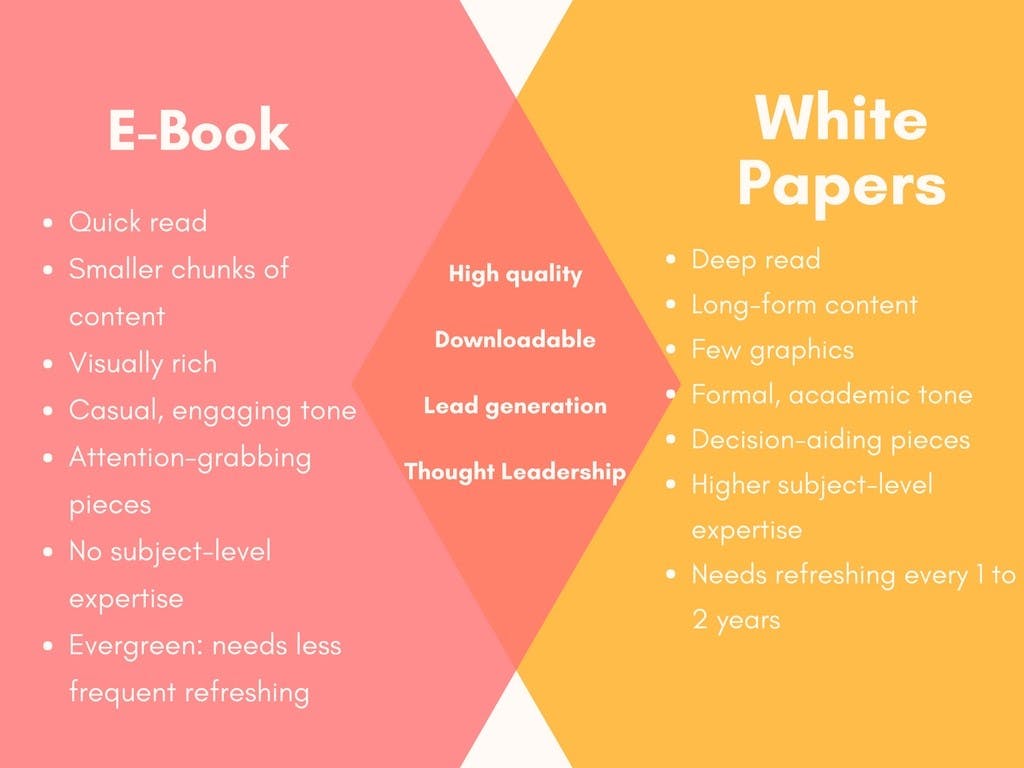
The primary difference between an ebook and a white paper is the audience. An ebook is a comprehensive guide on a specific topic targeted predominantly at a general audience. A white paper is an academic report that targets a niche audience of specialists and presents new research. The other difference is the objective. The purpose of a white paper is to educate the audience and highlight the brand’s value proposition. Ebooks are also more informative and comprehensive. These assets serve as guides for broader topics. Finally, ebooks are longer and have a formal structure, while white papers often include the following components: a problem, methodology, guidance, and resolution.
White paper vs blog article
A blog article is a piece of content posted on a blog which is a website or a section of the site. Blog article often includes text, images, and videos. A blog article aims to briefly overview the subject, generate leads , and market products and services. On the other hand, a white paper’s primary goal is to give a complete idea about the topic. Although blog articles can present facts, these content pieces are usually not data-focused and are much shorter than white papers.
The other difference between white papers and blog articles is the tone. White papers require an official and professional style, while blog articles can be written in a more informal manner. White papers require more research and provide a thorough analysis of a product or service. Therefore, completing a comprehensive white paper can take weeks to months. A blog article is more straightforward, so writing one can take a few hours to several days. White papers are designed to draw qualified leads and prospects, whereas blog articles are less technical and can reach a wider audience.
Once you are familiar with different content formats and their differences from a white paper, let us discuss the process of writing a white paper from ideation to publication and distribution.
An excellent white paper needs to be thoroughly researched and present new information that readers cannot find through an internet search. Moreover, a white paper should be engaging and maintain the audience’s interest. Now we will describe how to write an excellent white paper in greater detail below.
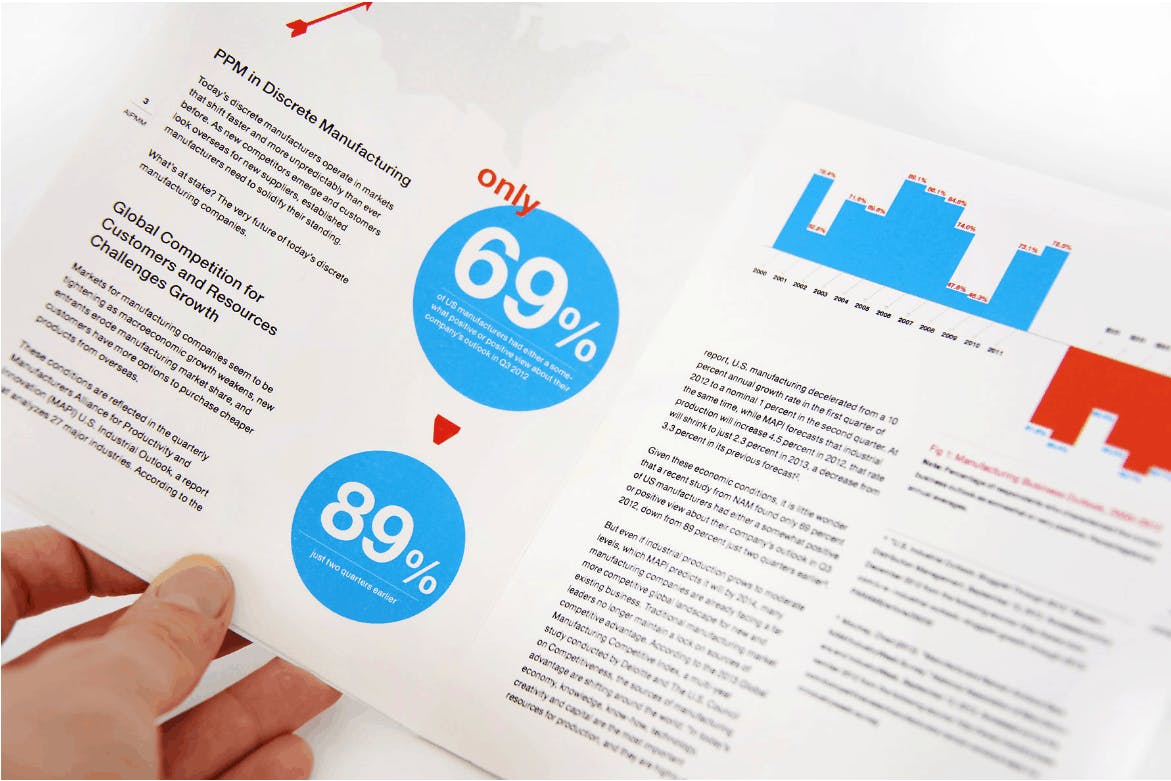
Step 1. Define your audience
Defining your audience is one of the most crucial steps in creating a well-researched white paper. First, you need to consider what kinds of readers you want to attract. For example, you can use specific jargon if your audience is professionals in the industry. Furthermore, the statistics and provided information should be relevant to your target audience. Knowing your readers’ interests also narrows the scope of research you should conduct.
When determining your audience, consider the following characteristics: educational background, job title, and professional needs. Think about which platforms and search queries your readers use to find information. Conduct in-depth research to understand why your audience is interested in this topic, how much knowledge readers already have about the subject, and how your white paper can help them. In addition, interview your clients and check the comments from your audience to learn about their main problems and goals.
Step 2. Choose a relevant topic and research it
Choosing an impactful topic for a white paper is a crucial component of its success. When defining the topic, make sure you are qualified to write about it and that your audience is interested in the problem. Beyond that, the topic should fill the content gap , which means that there should not be much information online on the subject. Your topic may concern a product or an innovative business idea. A white paper can describe a particular aspect of your business or your team’s accomplishments.
Ask your audience about their expectations, check other reports and studies to identify content gaps, and interview other industry experts to develop an idea for a white paper. Then find credible sources and collect expert opinions and statistics. Finally, fact-check the information to verify its accuracy.
Step 3. Make an outline
The following step is to create an outline that determines your target audience, defines the structure, and organizes the study. When creating a plan for your paper, think about how to summarize your findings in a way that addresses the issues of your readers. Make a list of concepts and crucial matters you should address within each section.
A white paper typically consists of the following elements: title, abstract or summary, introduction, section subheadings, sources, and conclusion. First, you need to describe a problem or situation. Secondly, you should provide a methodology and instructions. Finally, you need to explain possible solutions to the problem.
Step 4. Provide valuable information
It is critical to remember that a white paper’s goal is to provide helpful information to an audience even if they do not become your clients. Make sure each paragraph brings value and makes readers feel they have learned something new. A white paper should demonstrate your expertise in a particular field as a business or brand.
Use proven facts and statistics to make a white paper more trustworthy. Thus, your audience will perceive the company as a reliable source of information. In addition, building a reputation as an expert will increase your chances of achieving success, as customers are willing to buy from businesses they trust.
Now you need to format the content of your document. Use bullet points and subheadings to divide the text into sections and make it easier to read. You can also add charts and graphs to capture readers’ attention and highlight the concepts you want people to remember. You can decide how to format the paper by looking up various examples and templates.
Step 5. Proofread and edit
When writing a white paper, maintain a formal tone. Use language appropriate for the audience you are targeting. Avoid using informal language, slang, and expressions that are not suitable for academic writing. Although keyword optimization is crucial, remember to write for your readers instead of search engines. Google is constantly improving its capacity to recognize and match relevant information with search queries.
Do not worry about creating a perfect white paper on the first draft. It may require several revisions to finalize a report. To ensure your white paper is exciting and understandable, hire professional proofreaders or try editing a document yourself.
Step 6. Distribute and promote your paper
Creating the document is only the first step. You also need to ensure it reaches the desired audience. For instance, you can send a press release to advertise the publication of a new paper or share it through LinkedIn or Twitter. The other way to promote the publication of the white paper is to send it to your prospects after a demo call to provide more information. A smart strategy to distribute your white papers is to embed or link them to relevant landing pages, guest blogs, and newsletters.
White paper syndication or publishing the same document on independent websites enables companies to target a niche market , generate leads, and increase the reach of a white paper. Besides, a white paper distribution through content syndication is very effective as it allows for repurposing content and promoting it on various platforms.
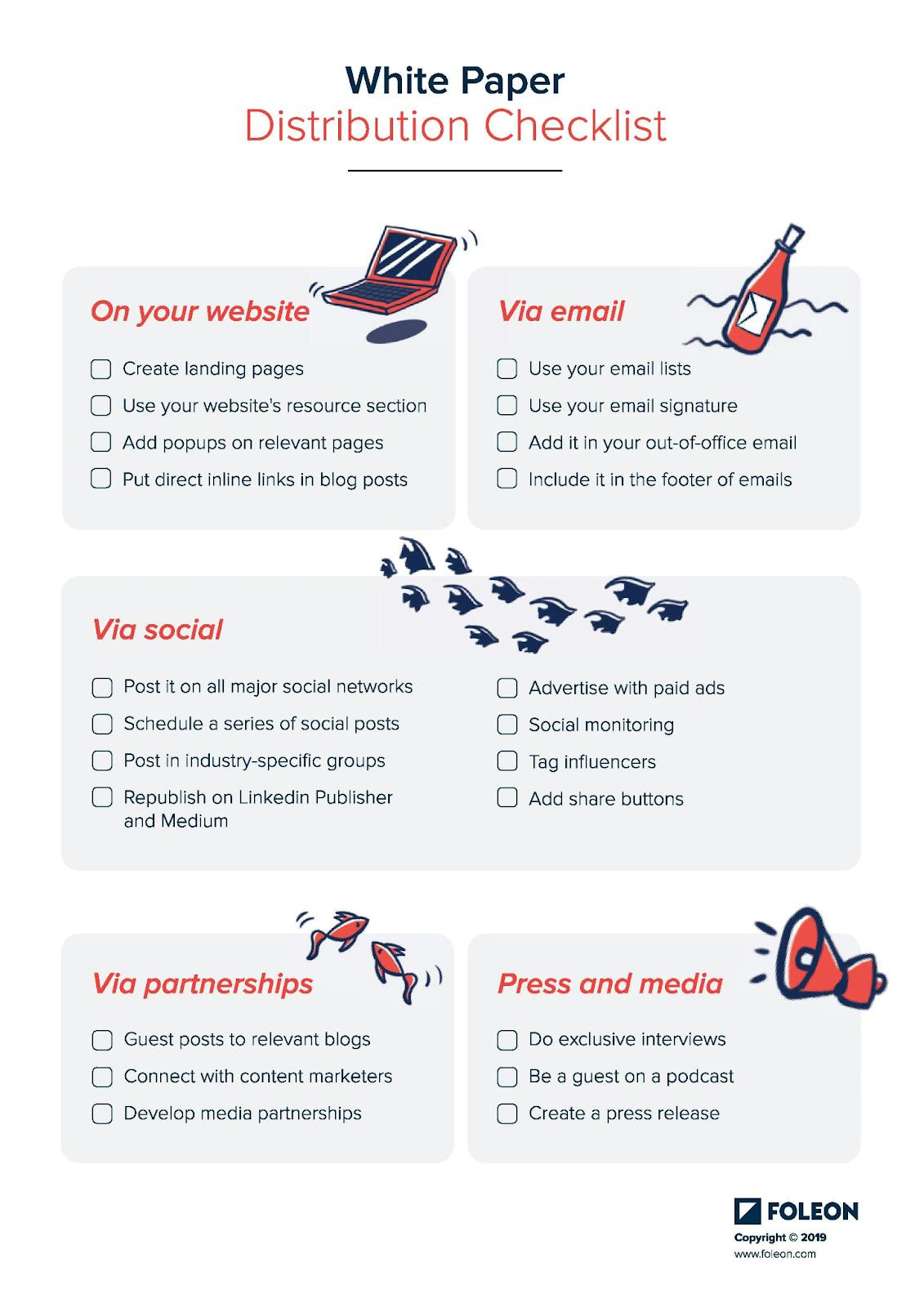
Next, we will look at white paper examples from different companies in various industries to provide you with an understanding of how to create a white paper.
In this section, you can find three white paper examples to collect ideas for creating your own.
Cisco’s white paper
Cisco is a company that develops and provides network equipment, data security services, and telecommunications gear. The company created a white paper called “Networking and your competitive edge” , where Cisco explained the importance of having a secure and reliable network edge. The advantages of this white paper are a large number of infographics, quotes, statistics, and balanced use of text and visuals. Plus, the document allows people to understand a complex topic with the help of the simple and engaging language of the presentation.
Google’s white paper
The white paper called “Cloud security and compliance” by Google is a 28-page tutorial demonstrating the effectiveness of Google cloud products and services in protecting the data of any workspace. The white paper has all the components of a well-written, readable document, including subtle color fonts, pictures, and plain language. What is more, Google repurposed the white paper and created the infographic for people who do not have time to read the entire document.
Uber’s white paper
In the paper called “Fast-forwarding to a future of on-demand urban air transportation” , Uber promotes the idea of air transportation and establishes the company as a key figure in its creation. The company describes its VTOL aircraft, explains the need for it in urban areas, and lists the obstacles that should be overcome. Uber also mentions reviewers from NASA, MIT, and other prestigious air transportation organizations to increase the report's credibility. As a result, the company establishes itself as a thought leader by describing future trends and innovations in the industry.
You can use the above-mentioned practices tested by reputable companies to create a white paper that will educate your audience, generate leads and increase sales.
Companies can use gated content like white papers to grow contact lists for marketing and sales teams. Gated content is any publication that readers can access by providing personal details like name and email. A company creates a landing page that contains a description of available content and a form where users can enter contact information and gain access to the materials.
There is no definitive answer to whether you should gate a white paper. On the one hand, gating your content is a great way to generate leads . Moreover, a successful buyer's journey often starts with gated content as the very first step. Most people who provide contact information are interested in your company because of your regular distribution of useful content.
On the other hand, gating your white paper reduces the number of people who will read the document because not everyone wants to share their personal details. Therefore, if your white paper is not gated, it will attract a larger audience and can improve your search rankings. However, gating a white paper will stop search engines from indexing a publication.
Creating a perfect white paper may require a lot of time and effort. Nevertheless, this results in a valuable document that promotes your company’s expertise and fosters general education and development in your industry. A perfect white paper contributes to the company’s growth.

- Marketing Strategy & Branding
- Content Marketing & SEO
- Product Focused Marketing
- Digital Experience Design
- Marketing Automation
- Video Production
© 2023 Awware

IMAGES
VIDEO
COMMENTS
Preprints, like academic journal articles, are assigned a Digital Object Identifier, or DOI, and become a permanent part of the scientific record. White paper. A white paper is a report, often compiled by government agencies, businesses and nonprofit organizations, that outlines an issue and often explores possible solutions to a problem.
A white paper, on the other sheet, is a tool to share information and influence decision-making. Research papers explore all existing knowledge and can never have enough of it. White papers focus on a handful of points. Just enough knowledge to help someone make the right decision and nothing more. Research papers expand the mind, white papers ...
Results. A research paper is written to present facts and results backed by credible data from other experts in the field and is meant to add to the overall knowledge on that specific topic, to encourage future research, or just clarify a certain fact. A white paper, on the other hand, is written with the intent to persuade the reader to reach ...
The Purpose of a White Paper. Typically, the purpose of a white paper is to advocate that a certain position is the best way to go or that a certain solution is best for a particular problem. When it is used for commercial purposes, it could influence the decision-making processes of current and prospective customers.
A white paper is an in-depth and authoritative report about a specific topic that introduces a problem, challenge or issue and provides a way to solve it. In other words, white papers are like advanced guides that help readers solve a particular problem. The term originated in England in the early 1900s to describe documents issued by the ...
Difference #3: The Results. If the goal of the white paper produced by a for-profit company is persuading the reader to reach a specific conclusion, then the desired result of that document is a sale by the company that sponsored it. A white paper may not contain a sales pitch, but its carefully crafted message is intended to guide the reader ...
White paper. A white paper is a report or guide that informs readers concisely about a complex issue and presents the issuing body's philosophy on the matter. It is meant to help readers understand an issue, solve a problem, or make a decision. Since the 1990s, this type of document has proliferated in business.
A white paper is an authoritative, research-based document that presents information, expert analysis and an organization or author's insight into a topic or solution to a problem. Companies or vendors use these papers in business-to-business (B2B) marketing models as part of a content marketing strategy. In these contexts, white papers are ...
A white paper is a research-based report which offers a focused description of a complex topic and presents the point of view of the author or body represented by the author. The purpose of a white paper is to give readers understanding of an issue, which in turn helps them solve a problem or make a decision.
A white paper is an academic report that targets a niche audience of specialists and presents new research. The other difference is the objective. The purpose of a white paper is to educate the audience and highlight the brand’s value proposition. Ebooks are also more informative and comprehensive.